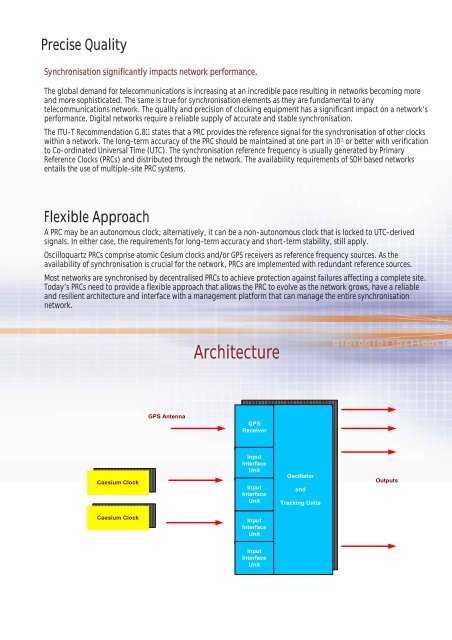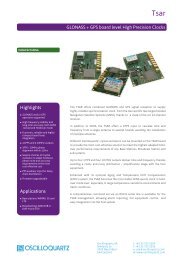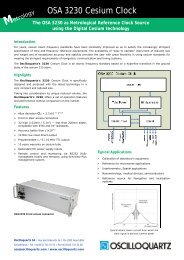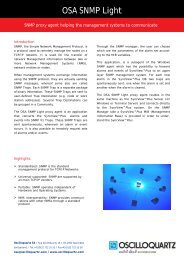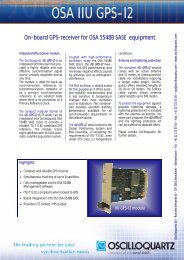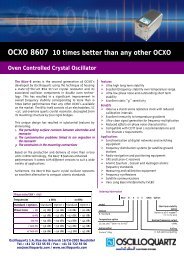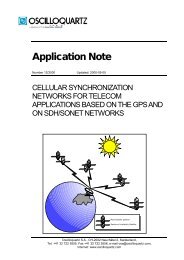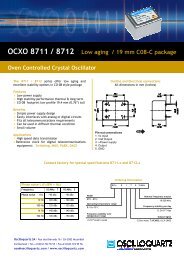OSA 6500 PRC - Primary Reference Clock - Oscilloquartz SA
OSA 6500 PRC - Primary Reference Clock - Oscilloquartz SA
OSA 6500 PRC - Primary Reference Clock - Oscilloquartz SA
Create successful ePaper yourself
Turn your PDF publications into a flip-book with our unique Google optimized e-Paper software.
Precise Quality<br />
Synchronisation significantly impacts network performance.<br />
The global demand for telecommunications is increasing at an incredible pace resulting in networks becoming more<br />
and more sophisticated. The same is true for synchronisation elements as they are fundamental to any<br />
telecommunications network. The quality and precision of clocking equipment has a significant impact on a network’s<br />
performance. Digital networks require a reliable supply of accurate and stable synchronisation.<br />
The ITU-T Recommendation G.811 states that a <strong>PRC</strong> provides the reference signal for the synchronisation of other clocks<br />
within a network. The long-term accuracy of the <strong>PRC</strong> should be maintained at one part in 1011 or better with verification<br />
to Co-ordinated Universal Time (UTC). The synchronisation reference frequency is usually generated by <strong>Primary</strong><br />
<strong>Reference</strong> <strong>Clock</strong>s (<strong>PRC</strong>s) and distributed through the network. The availability requirements of SDH based networks<br />
entails the use of multiple-site <strong>PRC</strong> systems.<br />
Flexible Approach<br />
A <strong>PRC</strong> may be an autonomous clock; alternatively, it can be a non-autonomous clock that is locked to UTC-derived<br />
signals. In either case, the requirements for long-term accuracy and short-term stability, still apply.<br />
<strong>Oscilloquartz</strong> <strong>PRC</strong>s comprise atomic Cesium clocks and/or GPS receivers as reference frequency sources. As the<br />
availability of synchronisation is crucial for the network, <strong>PRC</strong>s are implemented with redundant reference sources.<br />
Most networks are synchronised by decentralised <strong>PRC</strong>s to achieve protection against failures affecting a complete site.<br />
Today’s <strong>PRC</strong>s need to provide a flexible approach that allows the <strong>PRC</strong> to evolve as the network grows, have a reliable<br />
and resilient architecture and interface with a management platform that can manage the entire synchronisation<br />
network.<br />
GPS<br />
Caesium Receiver <strong>Clock</strong><br />
GPS<br />
Caesium Receiver <strong>Clock</strong><br />
GPS Antenna<br />
Architecture<br />
GPS<br />
Receiver<br />
Outputs<br />
Input<br />
Interface<br />
Unit<br />
Oscillator<br />
Input<br />
Output Signal Generator<br />
and<br />
Interface<br />
Unit Tracking Units<br />
Input<br />
Interface<br />
Unit<br />
Input<br />
Interface<br />
Unit<br />
Outputs


